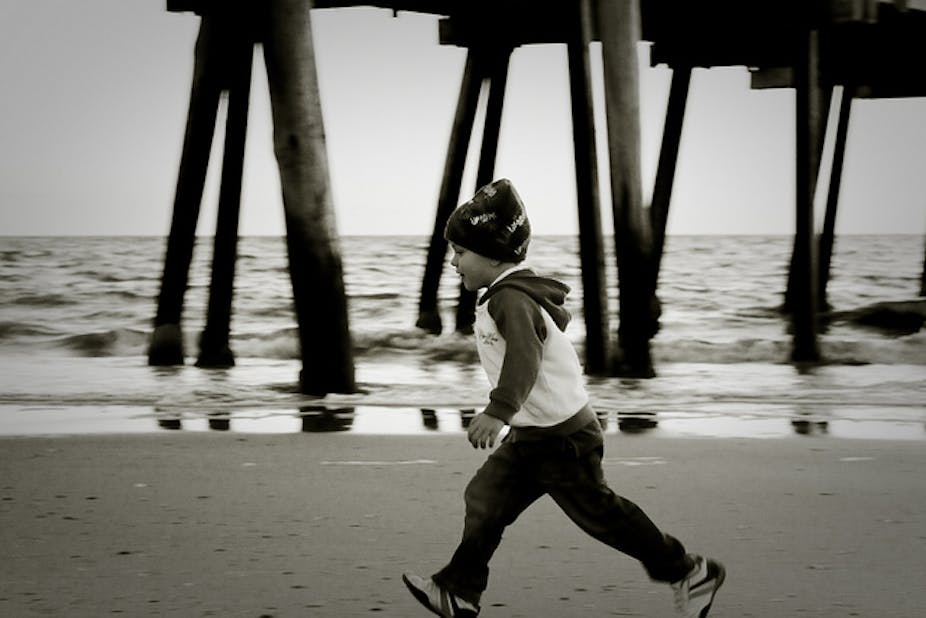Public health experts, educators and the media constantly remind us that children should put down the video games and get active. But how much activity is really necessary to maintain health? And how much is too much for the younger person?
The National Physical Activity Guidelines for Australians aged two to 12 years recommend a combination of moderate to vigorous activities for at least 60 minutes a day. About 60% of school-aged children meet these recommendations.
A reasonably high proportion of Australian children participate in sport – around two-thirds of Australian girls and three-quarters of boys. But fitness levels are declining, which suggests participation alone isn’t enough.
The number of sport-related injuries in children is also increasing. It’s estimated that nearly half of all sports-related injuries in children and adolescents are caused by over-use. But it’s unclear whether this is a result of poor skill, inadequate preparation for sport, or simply a consequence of changing lifestyles, where children are less able to enjoy free play.
Over-use injury
Over-use injuries of the bone, muscle and tendon can occur when these tissues are subjected to repetitive stress without sufficient time to heal or undergo the natural reparative processes. The risk is more serious in younger, pre-adolescent athletes because the growing bones can’t handle as much stress as the mature bones of an adult.
A young gymnast, for instance, may develop spondylolysis (a stress fracture of the spine) through repetitive hyper-extension activities combined with high-impact landings.
Or a young swimmer may develop rotator cuff tendonitis (a painful condition that affects the shoulder muscles) through excessively loading the muscles at the extremes of flexibility.
Young distance runners who train excessively are at risk of osteochondrosis, a range of diseases to the parts of the bone where growth occurs and where tendons attach.
These risks are compounded by the young athlete’s inability to associate vague symptoms such as soreness or a drop in performance with injury and communicate this to the coach.

Over-training injury
Over-training or burnout is an equally insidious injury among young athletes. It can present in many different forms – both physical and psychological.
The most commonly reported symptoms include chronic muscle or joint pain, respiratory tract infections, mood disturbances, personality changes, loss of appetite, decreased in interest in training, and sleep disturbances.
The velocity of growth during adolescence places young athletes at greater risk of over-use injury, simply because their systems have not matured to the extent of an adult athlete. Rapid growth can also lead to muscle imbalance and reduced coordination, as soft tissue growth lags behind rapid bone growth.
Young athletes also have a greater susceptibility to heat exhaustion. The increasing popularity of endurance events such as triathlons, half-marathons and fun runs open young participants up to fatigue or weather-related exposure (both heat and cold) injuries. The simple advice is not too much and not too soon.
Year-round training in multiple events is also becoming more common, in an attempt to improve the young athlete’s performance in their chosen sport. But while it’s important for young people to try a variety of sports and not specialise in one too early, children also need time to recover – physically and mentally.
Understanding risk
It’s important to accept that young athletes are not small adults. Some of the factors that place young athlete at risk are intrinsic (gender, maturity, anatomical alignment, fitness, flexibility, strength, muscle imbalance, coordination, nutritional status) and others are extrinsic (sport played, position, playing surface, coaching experience, weather).
While some risk factors can be modified (with footwear, suitability to participate, rule/administrative modifications) some others need to be recognised and accommodated for.
There is also considerable variability in both physical and psychological maturation in young athletes of the same age. So the intensity, duration and frequency of training can’t be the same for all young athletes. This places greater emphasis on the coach and parents to be aware of the signs of over-training and burn-out and to intervene when appropriate.
There are, however, some general guidelines for training children and adolescents to reduce the risk of injury:
The training program should be specific to the individual;
The training should not be too specific to the sport. Ensure the training accentuates general fitness, avoids excessive volume, and encourages the young athlete to engage in a range of sports to ensure they develop a greater range of motor skills;
Training should take into account the level of performance required of the athlete and length of the season, and involve periodization (systematic cycling of training loads with rest periods) to allow them to recover both physically and psychologically.
The ultimate goal of sport is to promote physical activity and develop physical and social skills in the young athlete.
Unfortunately, that goal can get skewed towards those of the coach or parent who see in the young athlete their own career aspirations or unfulfilled childhood dreams, at the expense of the child.

